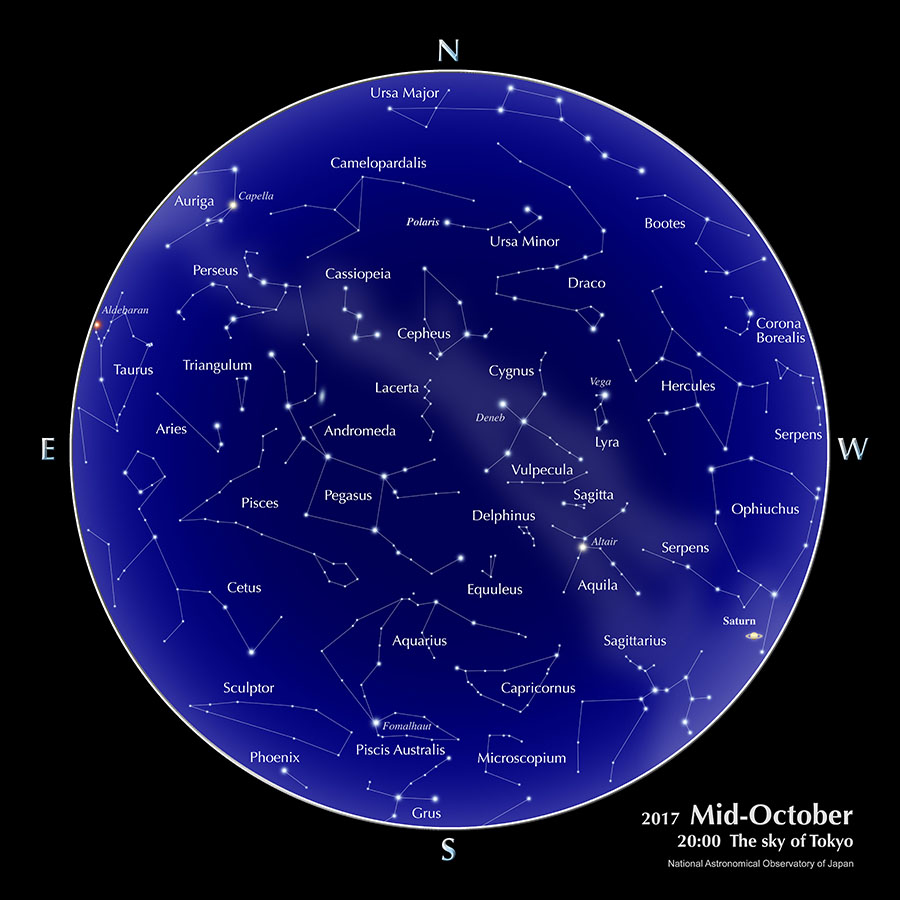The sky of Tokyo, Calendar, Planets (October, 2017)
The sky of Tokyo

Calendar (October)
| 4 | Chushu Moon |
| 6 | Full Moon |
| 8 | The October Draconid Meteor Shower peaks around this time. (The best time to observe is after sunset on the 8th. On the order of 4 meteors per hour are expected. Conditions are good for about 1 hour from when it gets dark after sunset until the Moon rises.) |
| 9 | Mercury at superior conjunction / Health-Sports Day [Taiiku-no-hi] (national holiday) |
| 10 | Occultation of Aldebaran (Mainly Northern Japan) / The Southern Taurid Meteor Shower peaks around this time. (The best time to observe is before midnight in the latter part of October, when there is no effect from moonlight. On the order of 2 meteors per hour are expected.) |
| 12 | Last Quarter Moon |
| 20 | New Moon / Uranus at opposition |
| 21 | The Orionid Meteor Shower peaks around this time. (The best time to observe is before dawn for about 4~5 days around this date. On the order of 5 meteors per hour are expected. There is no moonlight, so the conditions are very good.) |
| 27 | Jupiter at conjunction |
| 28 | First Quarter Moon |
The days for the peak activities of the meteor showers are based on the predictions of IMO(International Meteor Organization).
Planets
- Mercury
- At the beginning of the month, Mercury is positioned low in the eastern sky just before sunrise, but its apparent location is close to the Sun, making observation difficult. Mercury reaches superior conjunction on the 9th, after that it is positioned low in the western sky just after sunset.
- Venus
- Venus shines brightly low in the eastern sky before sunrise, but its elevation becomes lower. Its brightness is -3.9 magnitude.
- Mars
- At the beginning of the month, Mars is located in the constellation Leo and moves east. At the middle of the month it moves into the constellation Virgo. Mars can be seen low in the eastern sky just before sunrise. Its brightness is 1.8 magnitude.
- Jupiter
- Located in the constellation Virgo, Jupiter is positioned low in the western sky just after sunset. Its apparent location is close to the Sun making it unsuited for observation. Jupiter reaches conjunction on the 27th, after that it is positioned low in the eastern sky just before sunrise.
- Saturn
- Located in the constellation Ophiuchus, Saturn can be seen in the southwestern to western sky after sunset. At the end of the month, it sets before 20:00 as seen from Tokyo. Its brightness is 0.5 magnitude.
Source: Ephemeris Computation Office, NAOJ
With the “Sky Viewer” you can easily explore the appearance of a typical urban night sky (planets and constellations are visible). The Celestial Phenomena section of the glossary explains the planetary phenomena terms: greatest elongation, opposition, conjunction, stationary, etc.